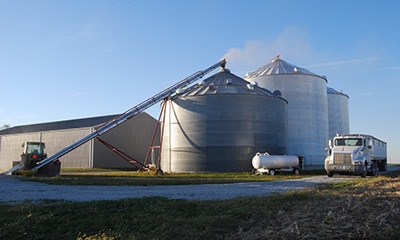November 4, 2015

Editor's note: Steve Johnson is the Iowa State University Extension farm management specialist for central Iowa.
The availability of on-farm storage can add harvest efficiency to a farming operation and flexibility to a grain marketing program. Storage enables the producer to use marketing tools that capture seasonal price increases and/or narrower basis levels following harvest. Storage facilities may also increase the rate at which harvesting can be completed by decreasing the time spent transporting and unloading grain.
Besides leaving additional time for futures prices and basis to improve, here are a few recommendations to consider:

BUILDING MORE BINS: Getting the most from on-farm storage requires careful planning to ensure the facilities fit your farming operation's needs. It also requires a commitment to managing stored grain properly to ensure quality and a commitment to learning how to do a better job of marketing grain.
1. Before you expand your storage, look at your farm's finances. What is your profit margin? How much and when are your cash flow needs? Is building more on-farm storage really the best use of your limited working capital? Deciding whether to expand your grain storage is not a one-size-fits-all situation.
2. If you've already added grain storage, integrate that information into your marketing strategies. Rather than selling grain because you've run out of space or you need cash, plan ahead to use your bins to make grain sales that take advantage of historical basis trends and deliver to processors when transportation and labor are readily available.
3. Work with your grain merchandisers and learn to use a variety of these marketing tools. When can you lock in the best basis, perhaps using a basis contract? When should you capture the futures carry using a storage hedge?
4. These marketing tools and even minimum price contracts are underutilized. Farmers can use on-farm grain storage to capture better basis, especially for corn. Perhaps you "lock in" an attractive basis seasonally and settle the final futures price with your grain merchandiser before May 1 or July 1, when you have a better chance to capture the higher futures prices. This describes what a basis contract provides.
5. Pay attention to seasonal futures prices and basis patterns, and act on them.
6. Be pragmatic in your pricing expectations and make incremental sales more often. These sales can have a big impact on your overall profitability and prevent getting blindsided by a steep drop in prices that lead to storing more bushels even longer.
~~~PAGE_BREAK_HERE~~~
Why build more grain storage?
With back-to-back large U.S. corn and soybean crops, the large decline in cash prices has many farms trying to determine whether their existing on-farm storage capacity is adequate. Consider these factors for building more storage:
•To improve harvest efficiency.
•To capture improved basis post-harvest.
•To reduce the cost of drying wet grain.
•To improve grain handling efficiency and using transportation and labor more effectively.
•To get a good return on investment for your farm's capital.
Preserve the quality of your grain
Grain should be as clean as possible before loading it into bins in order to reduce trash and fines. Good quality, clean, sound grain is much easier to store and market than cracked, broken grain.
To help preserve grain quality in storage, use the SLAM program: Sanitation, Loading, Aeration, and Monitoring.
•Remove all old grain from combines, truck beds, grain carts, bins, augers, and other equipment used for harvesting/transportation/storage. Even a small amount of insect-infested or moldy grain left over from a previous harvest can contaminate a bin of newly-harvested grain.
•Keep weeds down around bins to control insects and rodents.
•Inspect bins for holes, missing bolts, and rust, and caulk, patch, and make needed repairs to prevent water/rodent damage.
•Remove all debris from fans, exhaust vents and aeration ducts.
•After cleaning and repairing grain bins, sanitize walls, floors, under-floor areas, and roof areas inside and out with an approved residual spray.
•Once the outdoor temperatures drop in the fall, monitor the grain in on-farm storage every two weeks to observe moisture condensation or grain starting to smell musty.
For farm management information and analysis visit ISU's Ag Decision Maker site extension.iastate.edu/agdm; ISU Extension farm management specialist Steve Johnson's site is at extension.iastate.edu/polk/farm-management.
You May Also Like




